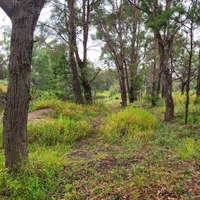Berrima Wildlife Reserve (2022 -
The Berrima Wildlife Reserve Landcare Group meets on 2nd and 4th Tuesday of each month from 9 am to 12 midday. It is a vibrant group of enthusiastic Landcare volunteers working to rejuvenate a beautiful piece of the Southern Highlands along the Wingecarribee River. New volunteers are always welcome. Feel free to drop in an have a look at what we are trying to achieve. Morning tea is around 10.30 am. Please contact Jenny Slattery the Landcare Convenor if you require more details via email at berrima.landcare@gmail.com
The Berrima Wildlife Reserve covers an area of over 20 hectares at the northern end of Sutton Street, Berrima. The reserve is comprised, in the main, of open woodland leading down to the riparian zone along the Wingecarribee River (part of the Sydney Water catchment). The quality of the woodland varies, but fortunately it contains a number of healthy cores of vegetation that will be strengthened and expanded over time. There is also a disused cricket field at the southern end of the reserve which is now mainly weedy grasses and evidence of historical buildings from the time the area was used to detain German prisoners during World War 1.
The Berrima Wildlife Reserve is situated on crown land and administered by a group of trustees. The in 2021 the trustees set up a Landcare group to maintain the remnant bushland on the reserve. The trustees and Landcare group aim to preserve the quality woodlands within the reserve, rehabilitate the areas infested with invasive weeds that are encroaching on endemic species as well as improve the quality of the riparian zone to provide habitat for local populations of platypus.
Aspirations
- To restore riparian habitat to a state that encourages the return of platypus to this section of the river.
- To provide safe, clear access to the public to sections of the reserve for walking possibly via boardwalks to discourage damage to the river frontage and riparian zone.
- To collect data on species found in the reserve overtime as a way of measuring the success of restoration work using the i-naturalist. The Atlas of Living Australia is a database that collects information about species from a number of sources. Species that have been observed and recorded in the reserve or near by can be explored by clicking here.





